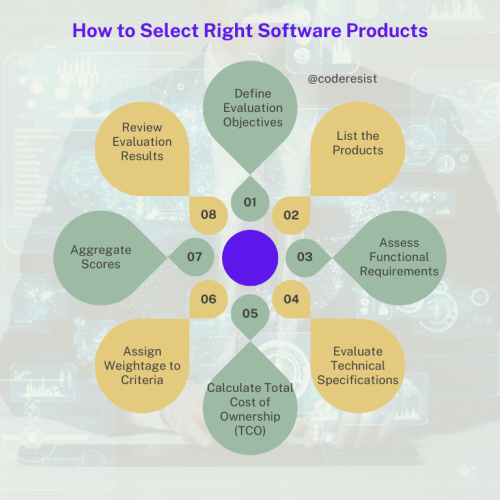Mastering Software Product Comparison: Why It Matters and How to Do It Right
In today’s competitive market, selecting the right software product for your business can be a daunting task. To help you make an informed decision, we present a comprehensive guide on software product evaluation. This guide will walk you through a structured evaluation process, ensuring you choose a product that meets your business needs and budget.
Why Do We Need Product Comparison/Evaluation?
Product comparison and evaluation are critical in ensuring that the software you choose aligns with your business goals and operational requirements. It helps in identifying the strengths and weaknesses of different products, allowing you to make a data-driven decision.
Example: Evaluating different CRM systems can reveal which one offers the best integration with your existing email marketing tools.
Importance of Software Product Evaluation
- Informed Decision Making: A thorough evaluation provides you with the necessary information to make an informed choice.
- Cost Efficiency: Helps in understanding the total cost of ownership, including hidden costs.
- Risk Mitigation: Identifies potential risks associated with each product and prepares you to handle them.
- Alignment with Business Goals: Ensures the selected software aligns with your strategic business objectives.
Challenges in Software Product Comparison
- Complexity of Features: Evaluating complex features across different products can be challenging.
- Bias and Subjectivity: Personal preferences and biases can influence the evaluation process.
- Changing Requirements: Business needs may evolve, making it hard to select a future-proof solution.
- Integration Issues: Ensuring the new software integrates well with existing systems can be difficult.
Best Practices for Product Comparison
- Define Clear Objectives: Establish what you want to achieve with the software.
- Involve Stakeholders: Get input from all relevant stakeholders to understand their needs.
- Use a Structured Approach: Follow a structured evaluation process to ensure consistency.
- Consider Long-term Needs: Evaluate not just for current needs but also for future scalability and growth.
- Pilot Testing: Conduct pilot testing to see how the software performs in a real-world scenario.
Compare and evaluate any software before making your decision
How to Select Right Software Products

Step 1: Define Evaluation Objectives
Before diving into the evaluation, it’s crucial to define your objectives. Understand what you aim to achieve with the software and outline the key criteria that will influence your decision.
Example: If you’re evaluating project management software, your objectives might include improving team collaboration, tracking project timelines, and integrating with existing tools.
Step 2: List the Products
Compile a list of potential software products. This list should include all the products you are considering for evaluation.
Example: For project management, you might consider products like Asana, Trello, and Microsoft Project.
Step 3: Assess Functional Requirements
Evaluate the functional capabilities of each product. Create a list of essential features and rate each product based on how well it meets these requirements.
Example: Functional requirements for project management software could include task assignment, deadline tracking, and file sharing.
Step 4: Evaluate Technical Specifications
Analyze the technical aspects of each product, such as compatibility with existing systems, security features, and scalability.
Example: If you need software that integrates with your CRM, check if each product supports this integration.
Step 5: Calculate Total Cost of Ownership (TCO)
Consider the total cost of ownership, including initial purchase, implementation, training, and ongoing maintenance costs.
Example: A software product might have a low initial cost but require expensive training sessions and high maintenance fees.
Step 6: Assign Weightage to Criteria
Assign weightage to different evaluation criteria based on their importance. This helps in prioritizing the factors that matter most to your business.
Example: If security is a top priority, assign a higher weightage to security features in your evaluation.
Step 7: Aggregate Scores
Combine the scores from the functional, technical, and TCO evaluations based on the assigned weightages to get a final score for each product.
Step 8: Review Evaluation Results
Summarize the evaluation results and rank the products based on their final scores. This will help you identify the best product for your needs.
Example: After evaluating and scoring, you might find that Asana ranks highest due to its user-friendly interface and robust integration capabilities.
Choosing the right software product is crucial for your business’s success. By following this structured evaluation process, you can ensure that you make a well-informed decision. Remember to periodically review your software choices as your business needs evolve.
Software product evaluation is crucial because it helps ensure that the software you choose aligns with your business objectives, operational needs, and budget. It allows you to make informed decisions by comparing different products based on their features, technical specifications, costs, and overall suitability. This process helps mitigate risks, avoid unnecessary expenses, and select a solution that supports your business’s long-term growth and efficiency.
Common challenges in software product evaluation include:
- Complexity of Features: Comparing complex features across different products can be overwhelming.
- Bias and Subjectivity: Personal preferences and biases can influence the evaluation process.
- Changing Requirements: Business needs may evolve, making it difficult to select a future-proof solution.
- Integration Issues: Ensuring the new software integrates well with existing systems can be challenging. Addressing these challenges involves a structured approach, clear objectives, stakeholder involvement, and consideration of both current and future needs.
Best practices for conducting a software product evaluation include:
- Define Clear Objectives: Establish what you want to achieve with the software.
- Involve Stakeholders: Get input from all relevant stakeholders to understand their needs.
- Use a Structured Approach: Follow a structured evaluation process to ensure consistency.
- Consider Long-term Needs: Evaluate not just for current needs but also for future scalability and growth.
- Pilot Testing: Conduct pilot testing to see how the software performs in a real-world scenario. By following these best practices, you can ensure a thorough and effective evaluation process, leading to a well-informed software selection.










